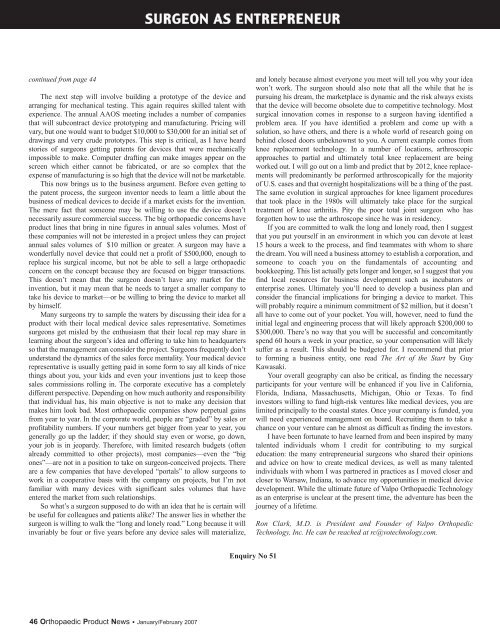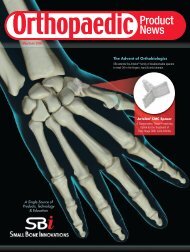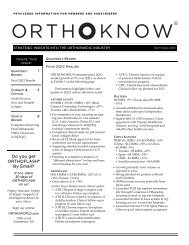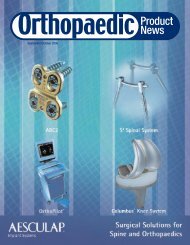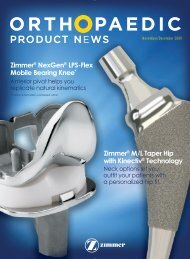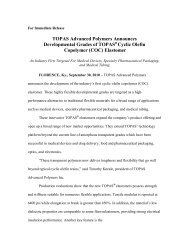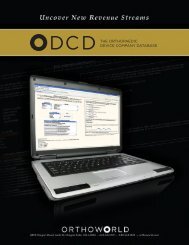AAOS, Arthroscopy - Orthoworld
AAOS, Arthroscopy - Orthoworld
AAOS, Arthroscopy - Orthoworld
Create successful ePaper yourself
Turn your PDF publications into a flip-book with our unique Google optimized e-Paper software.
SURGEON AS ENTREPRENEURcontinued from page 44The next step will involve building a prototype of the device andarranging for mechanical testing. This again requires skilled talent withexperience. The annual <strong>AAOS</strong> meeting includes a number of companiesthat will subcontract device prototyping and manufacturing. Pricing willvary, but one would want to budget $10,000 to $30,000 for an initial set ofdrawings and very crude prototypes. This step is critical, as I have heardstories of surgeons getting patents for devices that were mechanicallyimpossible to make. Computer drafting can make images appear on thescreen which either cannot be fabricated, or are so complex that theexpense of manufacturing is so high that the device will not be marketable.This now brings us to the business argument. Before even getting tothe patent process, the surgeon inventor needs to learn a little about thebusiness of medical devices to decide if a market exists for the invention.The mere fact that someone may be willing to use the device doesn’tnecessarily assure commercial success. The big orthopaedic concerns haveproduct lines that bring in nine figures in annual sales volumes. Most ofthese companies will not be interested in a project unless they can projectannual sales volumes of $10 million or greater. A surgeon may have awonderfully novel device that could net a profit of $500,000, enough toreplace his surgical income, but not be able to sell a large orthopaedicconcern on the concept because they are focused on bigger transactions.This doesn’t mean that the surgeon doesn’t have any market for theinvention, but it may mean that he needs to target a smaller company totake his device to market—or be willing to bring the device to market allby himself.Many surgeons try to sample the waters by discussing their idea for aproduct with their local medical device sales representative. Sometimessurgeons get misled by the enthusiasm that their local rep may share inlearning about the surgeon’s idea and offering to take him to headquartersso that the management can consider the project. Surgeons frequently don’tunderstand the dynamics of the sales force mentality. Your medical devicerepresentative is usually getting paid in some form to say all kinds of nicethings about you, your kids and even your inventions just to keep thosesales commissions rolling in. The corporate executive has a completelydifferent perspective. Depending on how much authority and responsibilitythat individual has, his main objective is not to make any decision thatmakes him look bad. Most orthopaedic companies show perpetual gainsfrom year to year. In the corporate world, people are “graded” by sales orprofitability numbers. If your numbers get bigger from year to year, yougenerally go up the ladder; if they should stay even or worse, go down,your job is in jeopardy. Therefore, with limited research budgets (oftenalready committed to other projects), most companies—even the “bigones”—are not in a position to take on surgeon-conceived projects. Thereare a few companies that have developed “portals” to allow surgeons towork in a cooperative basis with the company on projects, but I’m notfamiliar with many devices with significant sales volumes that haveentered the market from such relationships.So what’s a surgeon supposed to do with an idea that he is certain willbe useful for colleagues and patients alike? The answer lies in whether thesurgeon is willing to walk the “long and lonely road.” Long because it willinvariably be four or five years before any device sales will materialize,and lonely because almost everyone you meet will tell you why your ideawon’t work. The surgeon should also note that all the while that he ispursuing his dream, the marketplace is dynamic and the risk always existsthat the device will become obsolete due to competitive technology. Mostsurgical innovation comes in response to a surgeon having identified aproblem area. If you have identified a problem and come up with asolution, so have others, and there is a whole world of research going onbehind closed doors unbeknownst to you. A current example comes fromknee replacement technology. In a number of locations, arthroscopicapproaches to partial and ultimately total knee replacement are beingworked out. I will go out on a limb and predict that by 2012, knee replacementswill predominantly be performed arthroscopically for the majorityof U.S. cases and that overnight hospitalizations will be a thing of the past.The same evolution in surgical approaches for knee ligament proceduresthat took place in the 1980s will ultimately take place for the surgicaltreatment of knee arthritis. Pity the poor total joint surgeon who hasforgotten how to use the arthroscope since he was in residency.If you are committed to walk the long and lonely road, then I suggestthat you put yourself in an environment in which you can devote at least15 hours a week to the process, and find teammates with whom to sharethe dream. You will need a business attorney to establish a corporation, andsomeone to coach you on the fundamentals of accounting andbookkeeping. This list actually gets longer and longer, so I suggest that youfind local resources for business development such as incubators orenterprise zones. Ultimately you’ll need to develop a business plan andconsider the financial implications for bringing a device to market. Thiswill probably require a minimum commitment of $2 million, but it doesn’tall have to come out of your pocket. You will, however, need to fund theinitial legal and engineering process that will likely approach $200,000 to$300,000. There’s no way that you will be successful and concomitantlyspend 60 hours a week in your practice, so your compensation will likelysuffer as a result. This should be budgeted for. I recommend that priorto forming a business entity, one read The Art of the Start by GuyKawasaki.Your overall geography can also be critical, as finding the necessaryparticipants for your venture will be enhanced if you live in California,Florida, Indiana, Massachusetts, Michigan, Ohio or Texas. To findinvestors willing to fund high-risk ventures like medical devices, you arelimited principally to the coastal states. Once your company is funded, youwill need experienced management on board. Recruiting them to take achance on your venture can be almost as difficult as finding the investors.I have been fortunate to have learned from and been inspired by manytalented individuals whom I credit for contributing to my surgicaleducation: the many entrepreneurial surgeons who shared their opinionsand advice on how to create medical devices, as well as many talentedindividuals with whom I was partnered in practices as I moved closer andcloser to Warsaw, Indiana, to advance my opportunities in medical devicedevelopment. While the ultimate future of Valpo Orthopaedic Technologyas an enterprise is unclear at the present time, the adventure has been thejourney of a lifetime.Ron Clark, M.D. is President and Founder of Valpo OrthopedicTechnology, Inc. He can be reached at rc@votechnology.com.Enquiry No 5146 Orthopaedic Product News • January/February 2007


